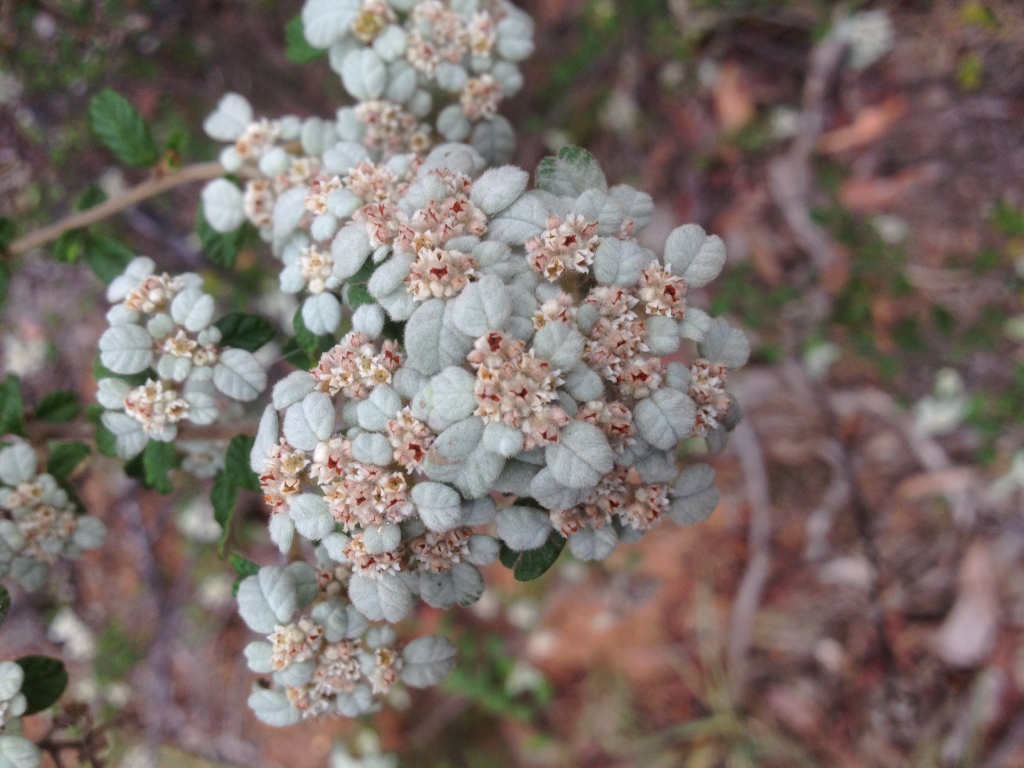Spyridium parvifolium
(Hook.) F.Muell. Dusty MillerSpreading shrub, procumbent to c. 1.5(–3) m high; branchlets densely pubescent to long-villous, often rusty. Leaves petiolate, obovate, elliptic or orbicular, 4–18(–30) mm long, 3–13(–20) mm wide, obtuse to emarginate, upper surface hispid to subvelutinous, rarely glabrous, usually with strongly impressed veins, lower surface densely whitish stellate-pubescent, with longer, often rusty simple hairs over veins, margins flat to recurved, sometimes crenate; floral leaves densely white-tomentose on upper surface; stipules brown, 1–4 mm long, ciliate, free. Flowers in heads that are cymosely arranged at ends of branches, each head subtended by 1–few floral leaves; perianth c. 2 mm long, whitish, externally villous; sepals c. 1 mm long; free part of the hypanthium minute; style c. 0.3 mm long, shortly 3-lobed. Fruit c. 3 mm long. Flowers mainly spring.
Wim, GleP, Brid, VVP, VRiv, GipP, OtP, WaP, Gold, CVU, GGr, DunT, NIS, EGL, EGU, WPro, HSF, HNF, OtR, Strz, MonT, HFE, VAlp. Also SA, NSW, Tas. Common and widespread in moist forest and heathland, usually growing on sandy loam or gravelly soils, occasional in drier heathy woodland (e.g. Maryborough district), but apparently absent from the Mornington Peninsula and Strzelecki Ranges.
Extremely variable, with a number of forms that may warrant formal recognition. Bentham erected 3 varieties: var. molle from Bass Strait islands, possibly concordant with the softly hairy, small-leaved plants of Wilsons Promontory and far eastern coastal heaths; var. hirsutissimum, which is uniformly villous or long-hispid and may be endemic in the northern Grampians (e.g. Mt Zero); var. grande described from the Dandenong Range, with leaves 25 mm long or more. Of these, the latter appears least distinct, but precise circumscription of any of Bentham's varieties is complicated by a range of intermediate and/or other equally distinct entities. A delicate small-leaved form from the Brisbane Range, with leaves only 3–5 mm long, often glabrous and apically notched appears noteworthy. Plants having uniformly grey-velutinous foliage have been collected from rocky sites in the Snowy River gorge, Wilsons Promontory and near Point Hicks. Apparent hybrids with S. vexilliferum occur e.g. near Portland, Wallaby Rocks in the Grampians, and perhaps near Anglesea. Spyridium x ramosissimum from the Grampians, is a hybrid between S. daltonii and S. parvifolium, occurring where both parents occur in the northern Grampians.
Walsh, N.G. (1999). Spyridium. In: Walsh, N.G.; Entwisle, T.J., Flora of Victoria Vol. 4, Cornaceae to Asteraceae, pp. 115–120. Inkata Press, Melbourne.
 Spinning
Spinning

